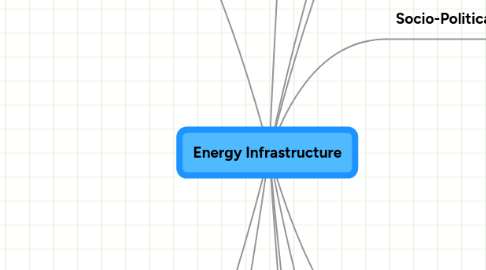
1. Processes
1.1. Discovery
1.1.1. Seismic
1.1.2. Drilling
1.1.3. Insolation
1.1.4. Wind patterns
1.1.5. Waves
1.1.6. Currents
1.2. Extraction
1.2.1. Mining
1.2.2. Drilling
1.2.3. In-situ
1.2.3.1. Shale oil
1.2.3.2. Coal
1.2.3.3. Hydrates?
1.3. Conversion
1.3.1. Chemical
1.3.1.1. Gasification
1.3.1.2. Fischer-Tropsch
1.3.1.3. Combustion
1.3.2. Nuclear
1.3.3. Thermo-Mechanical
1.3.3.1. Steam to electric
1.3.3.2. Solar Thermal
1.3.3.3. Combustion Turbine
1.3.4. Electro-Chemical
1.3.4.1. Solar PV
1.3.5. Photosynthetic
1.3.5.1. Biomass
1.3.5.2. "Green Solar"
1.4. Transmission
1.4.1. Pipelines
1.4.1.1. Oil
1.4.1.2. Gas
1.4.1.3. CO2
1.4.2. Wires
1.4.2.1. Copper
1.4.2.2. Superconductors
1.4.3. Ships
1.4.3.1. Oil
1.4.3.2. LNG
1.4.3.3. Coal
1.4.3.4. CO2
1.4.4. Rail
1.4.4.1. Coal
1.5. Distribution
1.5.1. Pipelines
1.5.2. Wires
1.5.3. Trucks
1.6. Storage
1.6.1. Batteries
1.6.2. Pumped Hydro
1.6.3. Tanks
1.6.3.1. Oil
1.6.3.2. Natural Gas
1.6.4. Compressed Air
1.6.5. Underground Natural Gas
1.6.6. Flywheel
1.6.7. Capacitor
1.7. End-Use
1.7.1. Heat
1.7.1.1. Space
1.7.1.2. Industrial processing
1.7.2. Lighting
1.7.3. Transportation
1.7.4. Electronics
1.7.5. Motors
1.7.6. Other machines
1.8. Waste Management
1.8.1. Bi-products
1.8.1.1. Sulfur
1.8.1.2. Gypsum
1.8.1.3. Asphalt
1.8.2. Storage
1.8.2.1. Atmosphere
1.8.2.2. Ocean
1.8.2.2.1. Diffuse
1.8.2.2.2. CO2 lake
1.8.2.2.3. Sediment as hydrate
1.8.2.3. Underground
1.8.2.3.1. Nuclear
1.8.2.3.2. Gases esp. CO2
1.8.2.4. Biomass
1.8.2.4.1. Trees
1.8.2.4.2. Soils
1.8.3. Dilution
1.8.3.1. Atmosphere
1.8.3.1.1. Urban pollutants
1.8.3.2. Water
1.8.3.2.1. Thermal pollution
2. Energy Inputs
2.1. Forms of energy carried
2.1.1. Electricity
2.1.2. Hydrogen
2.1.3. Hydrocarbons
2.1.3.1. Fossil
2.1.3.2. Biomass
2.1.4. Heat
2.2. Energy Sources
2.2.1. Intensive
2.2.1.1. Fossil
2.2.1.1.1. Coal
2.2.1.1.2. Oil
2.2.1.1.3. Gas
2.2.1.1.4. Tar sands
2.2.1.1.5. Oil shales
2.2.1.2. Nuclear
2.2.1.2.1. Fission
2.2.1.2.2. Fusion
2.2.1.3. Geothermal
2.2.2. Extensive
2.2.2.1. Hydro
2.2.2.2. Wave
2.2.2.3. Tidal
2.2.2.4. Wind
2.2.2.5. Solar
2.2.2.6. Biomass
2.2.3. Characteristics
2.2.3.1. Spatial distribution
2.2.3.2. Cost of extraction
2.2.3.3. Quantity
2.2.3.3.1. Resources
2.2.3.3.2. Reserves
2.2.3.4. Quality
2.2.3.4.1. Energy density
2.2.3.4.2. Purity
2.2.3.4.3. Intensity
3. About this map
3.1. Copyright 2007, Jim McFarland
4. Capital Inputs
4.1. Physical
4.1.1. Equipment
4.1.1.1. Turbines
4.1.1.2. Solar cells
4.1.1.3. Boilers
4.1.1.4. Pipes
4.1.1.5. Motors
4.1.1.6. Pumps
4.1.1.7. Catalysts
4.1.2. Suppliers
4.1.2.1. Processes
4.1.2.1.1. Engineering
4.1.2.1.2. Procurement
4.1.2.1.3. Fabrication
4.1.2.1.4. Construction
4.1.2.2. Services
4.1.2.2.1. Demand-side management
4.1.2.2.2. Peak shaving
4.1.2.2.3. Emissions trading
4.1.2.2.4. Site development
4.1.2.2.5. Fuel price hedging
4.2. Financial
4.2.1. Angel
4.2.2. Venture Capital
4.2.3. Equity
4.2.4. Institutional
4.2.5. Banking
4.2.6. Markets
4.2.7. Brokers
4.2.8. Traders
4.2.9. Government
4.2.9.1. Taxes
4.2.9.2. Subsidies
5. Labor Inputs
5.1. Educated
5.1.1. University
5.1.2. Other
5.2. Outsourced
6. Knowledge Supply
6.1. Operations
6.1.1. Private Industry
6.1.2. Consultancies
6.2. RD&D
6.2.1. Existing Industry
6.2.2. Government
6.2.3. Universities
6.2.4. Entrepreneurs
7. Socio-Political
7.1. Political
7.1.1. Supply Security
7.1.1.1. Threats
7.1.1.1.1. Embargo
7.1.1.1.2. Instability
7.1.1.1.3. Terrorism
7.1.1.1.4. Natural disasters
7.1.1.2. Impacts
7.1.1.2.1. Economy
7.1.1.2.2. National Security
7.1.2. Regulatory
7.1.2.1. Siting
7.1.2.2. Operations
7.1.2.3. Decommissioning
7.1.2.4. Standards
7.1.3. Legislative
7.1.3.1. Property rights
7.1.3.1.1. Intellectual
7.1.3.1.2. Physical
7.1.3.2. Fiscal
7.1.3.2.1. Taxes
7.1.3.2.2. Subsidies
7.2. Social
7.2.1. NIMBY, NUMBY, BANANA
7.2.2. Attitude toward energy
7.2.2.1. Right to cheap gas
7.2.2.2. Environmental awareness
7.2.2.3. Security
7.2.2.3.1. MEOW - Moral Equivalent Of War
7.2.2.3.2. Middle East entanglements
7.2.2.4. Willingness to pay for clean energy
8. Dynamics
8.1. Drivers
8.1.1. Population
8.1.2. Economy
8.1.3. Policy
8.1.4. Technology
8.1.5. Values
8.1.6. Public opinion
8.2. Growth
8.3. Scale
8.4. Investment
8.5. Time scales
8.5.1. Historic
8.5.2. Future
9. Related Networks
9.1. Transportation
9.1.1. Rail
9.1.2. Roads & Vehicles
9.1.3. Shipping
9.1.4. Air
9.2. Telecommunications
9.3. Water resources
9.3.1. Hydropower
9.3.2. Water supply
9.3.3. Water treatment
9.4. Agriculture
10. Network Characteristics
10.1. Flows
10.1.1. $
10.1.2. EJ
10.2. Nodes
10.3. Hubs
10.4. Mean shortest path length
10.5. Clustering coefficient
10.6. Fraction of nodes with x deg. of connections
10.7. Type of network
10.7.1. Small world
10.7.2. Free scale
10.7.3. Random
11. Tools & Methods
11.1. Cost Benefit
11.2. Life-cycle analysis
11.3. Trade-off analysis
11.4. Geographical information systems
11.5. Other
11.6. Disciplinary Frames
11.6.1. Science/Engineering
11.6.2. Economics
11.6.3. Business
11.6.4. Operations research
11.6.5. Political Science
11.6.6. Sociology/Psychology
11.6.7. History
11.7. Modeling
11.7.1. Top-down
11.7.2. Bottom-up
11.7.3. Hybrid
11.7.4. Optimizing
11.7.5. Behavioral
11.7.6. Agent-based
11.7.7. Recursive
11.7.8. Forward-looking
